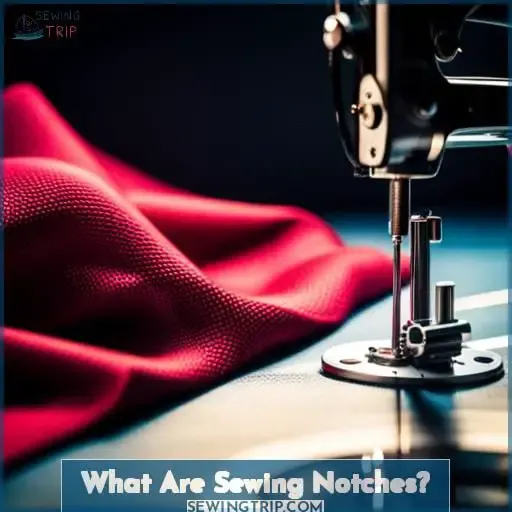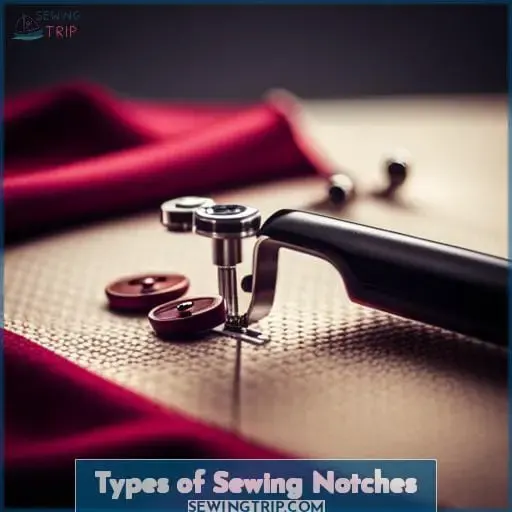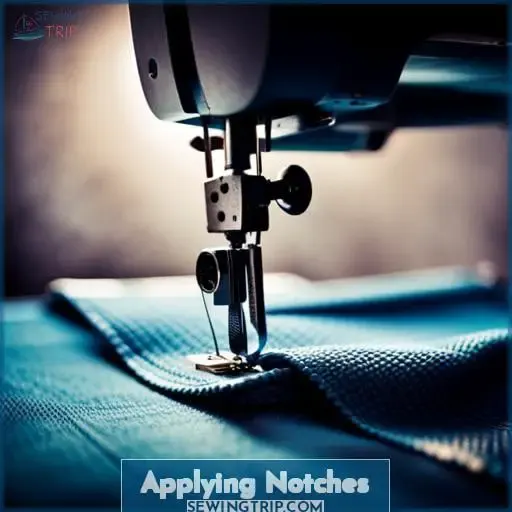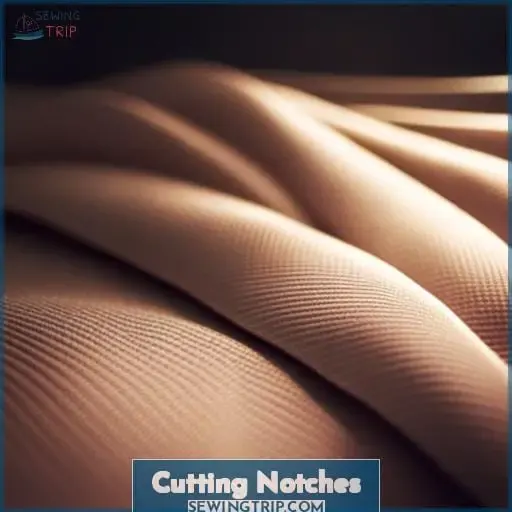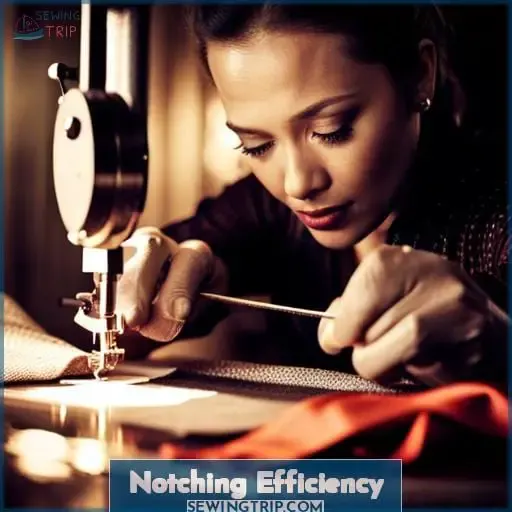This site is supported by our readers. We may earn a commission, at no cost to you, if you purchase through links.
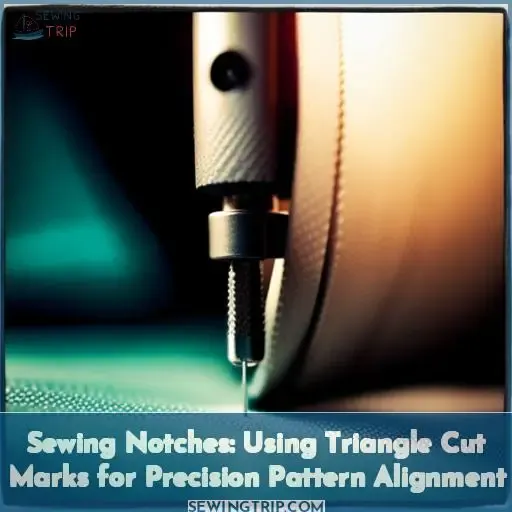 You’ve got the pattern pieces cut out, it’s time to start sewing. But those little notches along the edges have you stumped. Take heart, sewing novice, mastering notches is your first step to conquering pattern assembly.
You’ve got the pattern pieces cut out, it’s time to start sewing. But those little notches along the edges have you stumped. Take heart, sewing novice, mastering notches is your first step to conquering pattern assembly.
Ignore the triangles and you’ll likely end up with twisted seams or pieces sewn together backwards. Learn proper notching technique and your projects will start coming together perfectly aligned.
We’ll explore the main notch types and when to use each. You’ll practice transferring markings from paper to fabric. With the right tools and methods, you can cut notches quickly and precisely. And pro tips will have you notching efficiently, minimizing waste.
Follow this notch tutorial and you’ll gain confidence joining seams. Your sewjo will level up with new skills to tackle trickier projects. So grab those fabric scissors, it’s time to transform paper patterns into professional creations by mastering the deceptively simple art of sewing notches.
Table Of Contents
Key Takeaways
- Notches are crucial for accurate alignment and to prevent twisted seams and misalignment.
- There are three types of notches: inward-cut notches for sturdy fabrics, outward-cut notches for loosely woven fabrics, and T-shaped slash notches for complex projects.
- Notches should be transferred from paper patterns to fabric and matched with fabric orientation for accuracy.
- Efficient notching involves combining cutting and marking notches during fabric preparation, and experienced sewers also need to use notches for precise alignment.
What Are Sewing Notches?
When making your own clothes, those little triangle marks on the pattern pieces are a seamstress’s secret weapon for perfectly lined up seams.
Sewing notches are small triangular marks that indicate matching points when assembling a project. They function like a jigsaw puzzle, guiding you to connect the fabric pieces properly.
Understanding traditional notching techniques lets you align pattern pieces confidently. Choose notches suitable for your fabric’s fray factor. Cut them accurately after marking to avoid weak seams.
Beginners tend to overlook these vital markings. But mastering notching will result in smoother seams, perfect alignment, and a professional finish. With practice, notches become intuitive and transform flat fabric into flawless garments.
Types of Sewing Notches
When working with patterns, you’ll notice small triangular markings called notches. There are a few main types to be aware of: inward-cut notches within the seam allowance, outward-cut notches outside of it, and quick T-shaped slashes preferred by experienced sewers.
Inward-Cut Notches
Mind the permanent cut of those triangular notches within seam allowances if you’re working with fray-prone fabrics. Cut inwards carefully to avoid weakening seams on delicate materials. For alternatives, consider outward notches or T-shaped slashes – both minimize fabric fraying.
Triangle markings are common for beginner sewing but risk fraying. Compare notch shapes and applications to pick the best inward cutting tips for each project, aligning triangle wedges along the stitching line.
Outward-Cut Notches
Outward-cut notches – triangles outside the seam allowances – are beginner-friendly as they’re trimmed after stitching, aren’t they? So you can avoid permanent cuts while ensuring proper alignment, especially with fray-prone fabrics.
When marking notches, consider cutting methods, notch sizes, tools, shapes, and fabric stretch. Cut outward for non-fraying, unmatched, or stretchy fabrics. Mark single, double, T, or triangle notches based on pattern and project needs.
Removable outward notches prevent mistakes for sewing newbies. With practice, notch marking mastery enhances your sewing skills.
T-Shape Slash Notches
You’ll want to mark these quick T-shaped slashes for a clean, professional finish. They require precision, as any difficulty in adjusting the angles or lengths throws off the final alignment. Though some designers prefer other notches, these diamond markings save time and costs.
Carefully transfer the T’s from your high-quality sewing patterns onto your fabric before cutting. Ensure the slash direction matches the pattern’s intended seam edges. When sewing complex projects with many pieces, mastering fast yet accurate marking techniques prevents errors.
Applying Notches
When working with sewing patterns, it is crucial to carefully transfer notches from paper to fabric. Ensure proper orientation when marking the fabric, matching triangular wedges along seam edges. The notching style should align with the characteristics of both the pattern design and chosen fabric.
Transferring Notches From Paper Patterns to Fabric
Before cutting your fabric, transfer the pattern’s notches by matching the triangular wedges to the fabric with the proper orientation. Use fabric clips or tacking stitches for edge alignment when transferring diamond-shaped markings.
Consider notching methods like snips in seam allowances as marking alternatives before cutting your fabric and matching pieces. Sewing notches ensures successful garment assembly, so take care when transferring notches from paper patterns to fabric before cutting.
Matching Notches With Proper Fabric Orientation
When aligning notched fabric edges, envision triangular wedges meshing like puzzle pieces for a precise fit. As a sewing beginner building confidence, carefully prepare your fabric by checking grain alignment and seam finishing before cutting.
When matching triple notches, mind the iron temperature and thread tension settings to prevent distortion. Seam rippers quickly correct any misalignments. With practice, aligning fabric notches becomes second nature, empowering your sewing mastery through liberation from nagging doubts.
Aligning Notching Styles With Pattern and Fabric Characteristics
Like a skilled pianist aligning finger positions to the sheet music, you align the notching style with the pattern’s instructions and fabric’s temperament.
- Choose inward notches for non-fraying fabrics like felt that hold shape and need precise alignment.
- Opt for outward notches on loosely woven fabrics prone to fraying to avoid weakening seams.
- T-shape slash notches work well on patterns with many pieces or sections needing precise alignment.
- For multi-fabric projects, match notch style to the temperament of each fabric type.
When sewing a garment, you tune into the pattern and fabric like a maestro reading notes on a score, selecting notch shapes that enable the pieces to come together in perfect harmony. With experience, you gain an intuition for ideal notching approaches to gracefully assemble disparate fabrics into a melodious design.
Notching Techniques
When sewing pattern pieces together, choosing the right notching technique is crucial for achieving accurate alignment. Carefully select either inward, outward, or slash notches based on your pattern and fabric type, keeping in mind that outward notches can be removed after stitching if you’re unsure.
Inward, Outward, and Slash Notches
You’ll want to match the notching technique to your pattern and fabric type. For stable wovens, use inward notches cut precisely with sewing notch cutters – they ensure accuracy. Go for removable outward notches on loosely woven fabrics like crepe to avoid creasing or damage.
Slash notches made with fabric shears work well on knits and bias cuts. Choosing the right notch style prevents mistakes and creates a perfectly aligned garment you’ll love to show off.
Choosing the Appropriate Notching Style
Match your notching method to the pattern and fabric for flawless alignment. Choose inward notches for sturdy materials like denim or cotton. The permanent wedge cut holds its shape well. For silks or knits, avoid fraying with outward notches.
Trim after stitching for invisible notching. Learn when to apply the quick slash technique based on project needs. With practice, integrate optimal notching into your sewing process. Mastering notches for different fabrics takes your DIY projects and sewing skills to the next level.
Removability of Outward Notches
As those outward points are snipped off after stitching, you’re ensuring a clean seam inside and out. With outward notches, you have control over the timing of removal, allowing for perfect stitching alignment before trimming.
This also permits easier fabric manipulation when placing patterns. Ultimately, outward notches give you flexibility with seam finishing while still delivering precision.
Cutting Notches
Sew your seams with precision using these expert notching techniques. To create outward points, snip small triangles along seam allowances; for inward v-shapes, carefully slice into the fabric at precise angles to secure integrity; notch cutters and hole punches ensure uniformity.
Outward Points Method
Carefully cut outward-pointing triangles into seam allowances, ensuring proper alignment during assembly like a sewing sorcerer. Master speed and precision when cutting outward notches. Fold back fabric in a single layer before cutting precise triangles into the allowance for flawless alignment.
Mind the fabric’s orientation when marking, as improper positioning causes misalignment. Add snips near notches on seam allowances to ease folding and pinning. With practice, you can master this technique like a professional seamstress, achieving accuracy for even complex projects like a reversible back bow sunhat or quilted casserole carrier.
Inward V’s Method
You’ll want to be extra cautious when carving inward V’s so as not to weaken the seams.
- Keep your rotary cutter blade sharp for cutting precision.
- Consider pinking shears or zigzag stitches for fabric fray control.
- Adjust notch depth based on seam finish selection.
- Note fabric grain direction before cutting.
- Follow the pattern’s written instructions for optimal notch depth and placement.
- Test on scrap pieces first when starting a new sewing project.
Carefully cutting inward V notches prevents damaging your fabric and seams. Master this method for flawless garment construction.
Special Tools for Accurate Notching
Your notch punch and cutter become trusty allies when marking fabric accurately. Expertly transferring and cutting notches requires the right tools. Special scissors, seam rippers, notch rulers, and tracing notchers empower accuracy.
Try pin notching to mark without cutting. Sharp punches cleanly notch fragile or loosely woven materials. Invest in quality tools; precision leads to professional results. Master notching and unlock your creative potential.
Notching Efficiency
When applying notches, you can combine efficiency and accuracy. First, cut notches while transferring patterns to fabric to eliminate an extra step. Next, use simple lines instead of full triangles to mark notches faster. Finally, add a few snips in the seam allowance so pieces fold and pin together neatly during assembly.
Combining Cutting and Marking Notches
Try snipping your fabric while cutting out pattern pieces to save time marking notches later. As you trace and cut, make quick snips into the seam allowance to indicate where notches should be. This combines two steps into one for efficiency. Just be sure notches are the proper depth and shape according to the pattern’s guidelines.
With practice, you’ll become adept at cutting correct notch alternatives directly without needing to mark them afterward. Investing in quality notchers or snips speeds up the process. Master this efficient technique to gain confidence and mastery of notching.
Lines as Alternatives to Triangular Notches
When tracing patterns, lines can replace triangles for indicating notch locations. Using lines as alternatives to triangular notches has distinct advantages. It saves time while drafting and provides a quick reference when assembling.
Simply etching lines along seam lines when copying a pattern gives you all the guidance needed. With no precise cutting involved, lines offer a faster way to mark notches. For a trial garment, lines get the job done before committing to more intricate notching on the final piece.
Snips in Seam Allowance for Folding and Pinning
You can save tons of time during assembly by making quick snips in the seam allowance that act as guides when folding and pinning pieces together.
- Snip corners at points needing eased or gathered.
- Make slits at seam intersections for aligning corners.
- Clip inward curves so the edge can spread properly.
- Slice outward curves short of the stitch line to aid in handling.
With experience, you’ll find these simple snips invaluable for swift and hassle-free assembly. Gentle ironing, basting tape, and the right thread tension also facilitate smooth sewing.
Frequently Asked Questions (FAQs)
How do I transfer notches from a paper pattern to fabric?
Make small trims on the fabric as indicated before snipping pieces. Position similar shapes together while pinning the pattern to the material. Take care when cutting inward notches so that seams do not fray later. Align markings precisely during stitching for a flawless finish.
What tools can I use to cut notches?
You can choose between using notch cutters for quick and precise inward V cuts or notch punches for outward circles outside the seam allowances. Specialized tools like these allow for error-free notching compared to improvised methods.
Then, match the cutout shapes when pinning pattern pieces together, ensuring perfect alignment.
How deep should I cut inward notches?
When cutting inward notches, do not go too deep. Cut about halfway through the seam allowance to avoid weakening seams. This provides just enough clearance for matching notches without compromising structural integrity.
How do I know which type of notch to use?
You’ll know which notch to choose by feeling the fabric’s personality and listening to your project’s soul. Let triangular wedges be your guide, embracing fray-friendly notches where fabric whispers freedom.
Honor delicate textures with snips in the seam allowance, giving room for pinned perfection.
Can I skip using notches if I’m an experienced sewer?
Don’t be tempted to ditch them, sweetheart. Even expert sewers need those handy guides to prevent puckering. They’re vital time-savers that enhance accuracy. Skipping notches risks mismatched seams and frustration.
Trust the triangular friends that align your pieces perfectly. Master sewers know their worth.
Conclusion
Engage your notching know-how. Wield sharp wedges with wisdom to align wearables. Measure twice or risk wonky seams. Master inward V’s, outward points, slashes for sartorial success. Let triangle tips lead true. Mark mindfully, cut carefully, match methodically. Whether wielding a wheel or razor, notch nimbly.
Align, snip, fit, stitch – voila! Your creation takes shape. Now flaunt your handiwork with pride.

